
Carnegie Mellon Research Forecasts Nation’s AI Energy Needs
Media Inquiries
As artificial intelligence and digital infrastructure grow at unprecedented rates, researchers at Carnegie Mellon University, the birthplace of AI(opens in new window), are building sophisticated models to forecast the impact on the nation's power grid and to forge the path toward resilient, cost-effective and low-emission energy systems.
The Open Energy Outlook(opens in new window) initiative at CMU’s Wilton Scott Institute for Energy Innovation is modeling how large-scale digital infrastructure growth — driven by AI and cryptocurrency — could reshape the U.S. power sector, using data to explore scenarios that vary by region, resource availability and planning strategies.
“We’re pointing out challenges and wanted to offer some possible solutions,” said Michael Blackhurst(opens in new window), executive director of the initiative in Carnegie Mellon’s Engineering and Public Policy department(opens in new window) in the College of Engineering(opens in new window). “The degree to which policy actors are coordinating around the solutions is going to be important in terms of how effective those solutions are.”
Using estimates on the demand from digital infrastructure over the next five years, policies and planning done now could promote both digital progress and grid stability, according to the report, “Electricity Grid Impacts of Rising Demand from Data Centers and Cryptocurrency Mining Operations(opens in new window).”
AI boom stressing the grid
The digital infrastructure boom is outpacing the U.S. electricity system’s ability to respond. Data centers offer potential benefits but risk locking in higher emissions and driving up prices for households without proactive and coordinated planning. According to the report, data center and cryptocurrency mining will increase electricity demand by 350% by 2030.
Blackhurst said that until recently, data has been scarce regarding the capacity of data centers and their energy demands in order to make these kinds of predictions.
Model helps map smarter solutions
The team used the data in a model tasked with finding solutions that met the demands of the digital infrastructure while using the lowest cost options.
“Our models are least-cost optimization models,” Blackhurst said. “What that means is that given the demands placed on the electric power system — for servers, digital infrastructure and all the other demands — it'll find the least costly set of technologies to meet those demands.”
For industry leaders and developers, right now those energy demands are greater than the supply, said Param Singh(opens in new window), Carnegie Bosch Professor of Business Technologies and Marketing and associate dean for research at Carnegie Mellon's Tepper School of Business(opens in new window).
“The key constraint today isn’t what hyperscalers are willing to pay — it’s whether the electricity is actually available,” he said. “These companies can manage higher energy costs, but in many regions, the supply simply isn’t there at scale.”
To fill that gap, the demand is often filled by fossil fuel-powered plants.
“These are faster to deploy than renewable energy sources, but raise questions about long-term sustainability and local impact,” said Singh, whose research analyzes how location choices, energy availability and incentive structures affect the economic and environmental outcomes for the communities that host these facilities.
Short-term constraints, long-term possibilities
The Open Energy Outlook research team modeled ways the grid could expand to handle the rising demand while keeping emissions and costs in check. By combining consumption, capacity and climate data, the team’s work can give regional and national planners clearer insight into how today's decisions could shape the energy system for decades to come without locking in high-emissions infrastructure.
“There's a lot of interest in Congress on AI, energy and the emissions implications of AI,” said Paulina Jaramillo(opens in new window), a member of the research team and a Trustee Professor in Engineering and Public Policy at CMU. “Since we have the model, I asked the team if they could do some simulations to see if we could quantify the impact.”
Research from the Open Energy Outlook team suggests several state and federal policies(opens in new window) for consideration including fair cost allocations, which would shift costs to large users instead of individual families.
Economics of growing demand
A number of factors would influence how each individual ratepayer experiences increased costs, said Nicholas Z. Muller(opens in new window), Lester and Judith Lave Professor of Economics, Engineering and Public Policy in the Tepper School.
Additionally, data centers built to include a power generation source could be self-contained with less impact on the electric grid than ones that are not.
“The way in which these costs often get covered is through a process that involves producers and the Public Utility Commission, and this ultimately shapes the retail prices and rates that we see as consumers,” Muller said. “Some of that then is shouldered by the downstream entities that are ultimately using power through retail rates.”
Powering a more reliable future
Data centers need consistent sources of energy, which can be a challenge when relying on variable renewable energy.
“They can't suffer interruptions,” he said. “So we need to think about coupling the variable resources with backup technology or stored energy. And that's where batteries come in.”
One solution from Muller’s research(opens in new window) could be providing incentives to account for system instabilities and avoid imbalances, coordinated with power generation sources and transmission.
Colocating self-contained power generating sources alongside data centers, as Muller mentioned, could be effective depending on other factors, said Chris Telmer(opens in new window), associate professor of financial economics at CMU's Tepper School.
“Colocation of generation and load poses challenges to the traditional utility-company model,” he said. “Regulation will need to be more flexible than it has been in the past.”
Smarter tech, smaller footprint
In the same way the increased efficiency of LED lights reduced energy demand compared to incandescents, future demand may depend on technological advancement, which Carnegie Mellon researchers have well underway.
For example, CMU research teams are studying(opens in new window) large language models specialized for specific tasks that can then make them more efficient, and how more AI models may run locally, known as “edge computing,” instead of relying on data centers at all.
These CMU-led innovations could ultimately lead to reduced overall forecasted demands, Telmer said.
“Discoveries could be made regarding efficiencies in computer chips and other elements that power the AI industry, and it’s that uncertainty that is really the important one.”
Research from Carnegie Mellon, with its interdisciplinary atmosphere paired with its history of innovation in engineering, technology and business, has an important role to play, Singh said.
For instance, John Kitchin(opens in new window), who serves as the John E. Swearingen Professor of Chemical Engineering in CMU’s College of Engineering, is leading research that is exploring ways to convert stored energy from renewable sources through different chemical catalysts into fuels that can be used for transportation and industry.
What’s next for energy policy and planning
Future research could include testing the different policy strategies in the model to help predict or lessen financial impacts, said Jaramillo, who is currently serving as a climate Congressional Fellow in the Science & Technology Policy Fellowship program managed by the American Association for the Advancement of Science.
“The current analysis doesn't include any simulations on the effect of different policy mechanisms, so next steps would go a little deeper into our policy options and how effective they would be,” she said.
For energy policy to be effective and fair, research like what is taking place at Carnegie Mellon can lead to tools that show us how interventions ripple through the grid, the economy and emissions trajectories, Singh said.
“This is exactly the kind of systems problem Carnegie Mellon is built to tackle — where technical, economic and policy considerations need to be integrated to guide smarter, more balanced decisions. In my mind, this is really an economics plus engineering problem, and Carnegie Mellon is a great place to consider this,” he said.
A peer-reviewed version of the report is forthcoming. Projections used for the modeling come from Lawrence Berkeley National Laboratory, Electric Power Research Institute and Bloomberg.
The Open Energy Outlook research initiative is a collaboration between the Scott Institute for Energy Innovation(opens in new window) at Carnegie Mellon and North Carolina State University.







